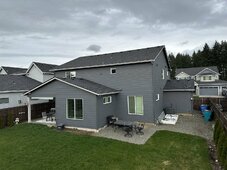Cowdog360
New Member
Hey all,
I'm in Washington state, and our electricity is super cheap at 8.7cents/kwh. So any solar system that I want to do with a less than 15 year payback pretty much has to be DIY. What I was hoping to do is have a system that can have a few batteries to act as a whole house UPS, and offset some of my daily usage.
I use about 55kwh/day as my house is predominantly electric with heat pump, heat pump water heater, etc, and an EV. Here are some shots of my backyard and the roof I have to work with. The main upper roof is west facing, the lower bump out on the house is south facing, and the small roof over the garage is also west facing. In the backyard, I have considered maybe a small ground mount setup where the kid's playset is. My tiny little 4x8 shed has a pair of 235W panels on it right now and just a single 12V 100ah battery and victron controller. It's mainly for charging up the batteries in the lawn equipment, but I'm also seeing if I can work it to provide enough oomph to power the pool filter in the summer (480W).
Since it's about $350 for the utility to hook up the net meter, I was considering just starting out with something smaller that I could consume during the daytime. Like maybe 4-6 of the 400W bifacials on that smaller lower south facing slant hooked up to an EG4 6000.
Question time: Am I going to need to move my loads I want to primarily run from solar and have the option to battery back to a sub-panel? I don't need the heat pump, water heater, EV, or clothes dryer on the solar side. I have a natural gas furnace that I could kick over to in the winter in a UPS situation, so I'd mainly want to run the house loads and furnace blower on the solar to start.
Thanks!


I'm in Washington state, and our electricity is super cheap at 8.7cents/kwh. So any solar system that I want to do with a less than 15 year payback pretty much has to be DIY. What I was hoping to do is have a system that can have a few batteries to act as a whole house UPS, and offset some of my daily usage.
I use about 55kwh/day as my house is predominantly electric with heat pump, heat pump water heater, etc, and an EV. Here are some shots of my backyard and the roof I have to work with. The main upper roof is west facing, the lower bump out on the house is south facing, and the small roof over the garage is also west facing. In the backyard, I have considered maybe a small ground mount setup where the kid's playset is. My tiny little 4x8 shed has a pair of 235W panels on it right now and just a single 12V 100ah battery and victron controller. It's mainly for charging up the batteries in the lawn equipment, but I'm also seeing if I can work it to provide enough oomph to power the pool filter in the summer (480W).
Since it's about $350 for the utility to hook up the net meter, I was considering just starting out with something smaller that I could consume during the daytime. Like maybe 4-6 of the 400W bifacials on that smaller lower south facing slant hooked up to an EG4 6000.
Question time: Am I going to need to move my loads I want to primarily run from solar and have the option to battery back to a sub-panel? I don't need the heat pump, water heater, EV, or clothes dryer on the solar side. I have a natural gas furnace that I could kick over to in the winter in a UPS situation, so I'd mainly want to run the house loads and furnace blower on the solar to start.
Thanks!




